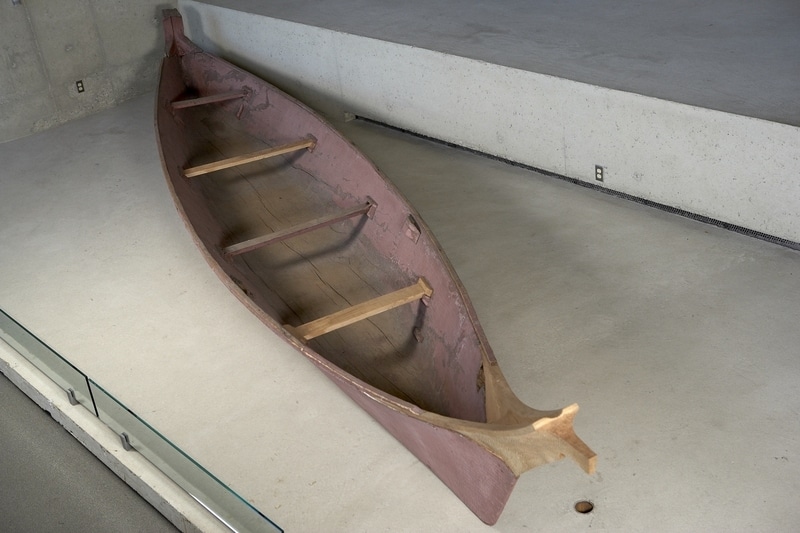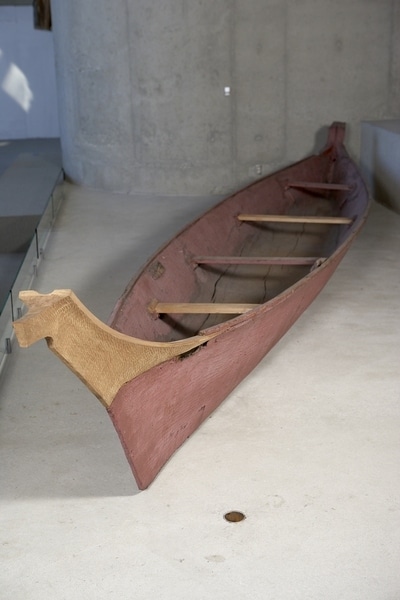Canoe Item Number: Nb11.353 a-b from the MOA: University of British Columbia



Description
Nuu-chah-nulth style dugout canoe with fine overall adze work. Most of canoe is covered in paint (currently pink; originally red) except for the bottom interior of the hull. Two original seats are still in place; the two missing seats were replaced with new boards in 2006. Original prow (wolf's head) no longer with canoe; new unpainted prow carved and added in 2006. The stern piece has become detached (part b), but is sitting loosely in place.
History Of Use
With its slender, arching prow and upright stern, this vessel is typical of the sealing canoes made by the Nuu-chah-nulth people from the west coast of Vancouver Island. The notch in the top of the prow was designed as a harpoon rest. Renowned as canoe makers and whalers, the Nuu-chah-nulth developed a range of canoe styles: hunting vessels, enormous freight canoes, and whaling canoes built to traverse the rough, open ocean up to 40 kilometres offshore. Some of these canoes were fitted with masts and sails. Canoes represent the long history of trade relations between the Nuu-chah-nulth and Kwakwaka'wakw.
Narrative
Obtained by Marius Barbeau from the Cadwallader family of Fort Rupert, however this canoe was almost certainly made by a Nuu-chah-nulth canoe maker. Notes refer to it having a prow in the shape of wolf's head. The original prow is thought to have been broken in 1951 when the canoe was on display outdoors. The new prow piece and 2 replacement seats were made and installed October 4-7, 2006 by Joe Martin (Tla-o-qui-aht), and his assistant, in a restoration project. Based on the original nails and construction methods Martin estimated that the canoe would not be older than the 1930s.
Item History
- Made by Joe Martin (Technician) in Vancouver Island, British Columbia, Canada during 1930
- Collected by Marius Barbeau and Arthur Price in Fort Rupert, British Columbia, Canada and Tsaxis, British Columbia, Canada during 1947
- Owned by Cadwallader Family and Committee on Totem Poles before 1947
- Received from Committee on Totem Poles (Transferring institution) during 1947
What
- Name
- Canoe
- Identification Number
- Nb11.353 a-b
- Type of Item
- canoe
- Material
- red cedar wood, metal and paint
- Part A
- height 111.9 cm, width 129.0 cm, depth 720.0 cm
- Part B
- height 49.2 cm, width 35.3 cm, depth 47.8 cm
- Overall
- height 1.1 m, width 1.3 m, depth 7.6 m
Who
- Culture
- Nuu-chah-nulth and Kwakwaka'wakw
- Creator
- Joe Martin (Technician)
- Field Collector
- Marius Barbeau and Arthur Price
- Previous Owner
- Cadwallader Family and Committee on Totem Poles
- Received from
- Committee on Totem Poles (Transferring institution)
Where
- Holding Institution
- MOA: University of British Columbia
- Made in
- Vancouver Island, British Columbia, Canada
- Collected in
- Fort Rupert, British Columbia, Canada and Tsaxis, British Columbia, Canada
When
- Creation Date
- during 1930
- Collection Date
- during 1947
- Ownership Date
- before 1947
- Acquisition Date
- during 1947
Other
- Condition
- fair
- Accession Number
- 2106/0009 a-b